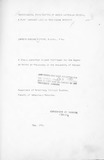| dc.description.abstract | Gnidia latifolia (Meisn is an ubiquitous woody shrub found in
the semi-arid areas of the Kenya highlands. Where it occurs, it is known
to be both poisonous as well as therapeutic. It is used to treat open
wounds and mange in goats. This study was undertaken to investigate
its effects and those of its constituent extracts on animals. An
attempt was made to establish the mode of toxicity of 9n. latifolia
(Meisn) by relating the clinical signs to the tissue changes in the
living animal.
Cattle and Weaner rats were used to study the pathological
effects of the toxic principle of Cn, latifolia (meisn). The Leaves and
bark were pulverized and suspended in cold tap-water. The suspension
was then used to drench bull calves, 4-9 months old at various doses.
Toxicity in the calves was monitored by Observing symptoms, serum
biochemistry and haematological changes. Cross pathology and
histopathology were recorded in all calves that succumbed.
Pulverized leaves, flower and bark were extracted using water,
methanol, ether, chloroform and ethanol. Fractions obtained were tested for
toxicity by injecting them intraperitoneally into weaner albino
Wistar rats. Methanol, ether, chloroform and water extracts were nontoxic
to rats at dose levels below 2 gm/kg. body weight. The ethanol
extract was toxic to the rats and was used for subsequent toxicologic
experiments. The length of time it took the various groups of animals
to succumb to the toxic constituents were also recorded.
In calves on feeding trials for 2-3 months the most significant
gross and microscopic lesions were observed in the liver, kidneys and
the lymphatic system. There were marked tissue wasting accompanied by
serous effusions into the peritoneal, pericardial anc pleural cavities.
The livers of cattle had extensive hepatic fibrosis Especially around
the portal triads. Varied degrees of degeneration of the hepatic cells
and fibrous tissue proliferation were noted in all the calves fed
pulverized leaves. Lymphopoietic follicles in the spleen and lymph
nodes showed cell necrosis, haemorrhages, congestion and "Fibrosis.
Chronic kidney lesions consisted of degenerative nephrosis and
glomerulonephritis, accompanied by marked deposition of hyaline casts
in the periglomerular spaces and proximal tubules. Haematological
studies on calves showed slight anaemia and a marked lymphopaenia.
Serum biochemistry showed slight increase in the aspartate amino
transferase (AST), formerly called serum glutamic oxaloacetic
tra saminase (SGOT). There were also slight increases in lactate
deb drogenase (LDHl and blood urea nitrogen (BUN).
The pathological changes seen in the weaner eIbino Wister rats
depended on the dosage and the length of time the animals were injected
with the toxic extract before succumbing. The ethanol extract was
quantitated and measured amounts were injected intraperitoneally into
the weaner rats. The rats were observed for toxic effects. The median
lethal dose for the ethanol extract was 262 mg/kg. body weight. The rats
that received doses much higher than the LDSD showed acute death with
necrosis of tissues that have fast-multiplying cells. There were marked
haemorrhages of the thymus. spleen. pancreas and the small intestines.
Some of the rats injected with dosages below the LD50 showed poor body
weight gains.
Histopathological sections from treated rats revealed a marked
cellular degeneration in the parenchymatous organs with proliferation
of the fibroblastic cell types replacing lymphoid and acinar cells.
The organs that are involved in mononuclear cell production were most
severely affected leaving either partially empty follicles or follicles
filled with cell debris. The kidneys. liver and the adrenal body
showed marked cellular degeneration with hyaline casts deposited and
filling proximal tubules of the kidneys and sinusoidal spaces of the
liver and adrenal body. In some of the histological sections. the.
albuminous casts were so extensive that they elicited inflammatory
cell reactions. Petechial haemorrhages were seen 1n severe1 organs such
as the kidneys, the pancreas, the adrenal cortex and medulla, the
thymus and the lymph nodes.
The ethanol extract from the pulverized loaves was precipitated
in petroleum spirit yielding about 11 gm/lOO gm of the dry matter. The
extensive cellular damage seen in the vital body organs especially those
with fast-multiplying cells suggests the need for additional research
on the plant. It is important to establish whether the selective
effect is constant for all dosage levels far below the LD50• Further
investigation should also be carried out on poisonous plants to determine
the usefulness of their active principles | en |

